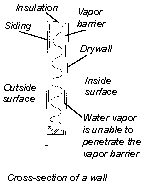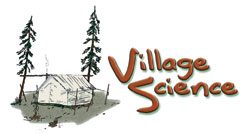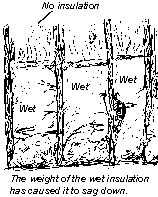Insulation & Vapor Barriers
|
A vapor barrier is usually a sheet of plastic, commonly called
“Visquene,” through which air and water cannot pass.
A home that has a vapor barrier installed properly will be warm, dry, and will last a long time. A modern Alaskan house that doesn’t have a vapor barrier, or has one installed improperly, will have major problems. |
||||
RottingWood will not rot if it is kept dry. The bacteria that destroy wood fibers need four conditions to grow:
If any of these four is removed, the bacteria cannot grow. In the frame of a house, there is both wood and oxygen. As soon as there is moisture and enough heat, bacteria can grow, destroying the wood fibers. We must keep water out of our ceilings, walls, and floors whether it is water leaking from the roof or water from vapor. |
|||||
PrincipleWarm air can hold more water vapor than cool air. When air is warmed, it removes water from other surfaces until it is saturated. This is why we hang our clothes outside in the summer or over the stove in the winter. Warm air removes the water from the clothes by evaporation. Water that is suspended in air is called vapor. When warm air is cooled, it must release some of the water vapor it carries. The water condenses out of the air. Heat is released when vapor condenses. |
|||||

|
Need for Vapor Barrier in the HouseIf the air in a house had no vapor, there would be constant static electricity, much of the woodwork would crack, people would have a hard time breathing, and would often get bloody noses. We see a degree of this when it is -40° or -50°F and there is very little vapor in the air. People breathing, coffee pots brewing, and cooking pots all add moisture to the air. When we go outside in the winter we “see our breath.” In reality, we see the vapor in our breath condensing. We never see the carbon dioxide and other gasses. When we are inside a warm house, the same amount of vapor is in our breath but we don’t see it. In winter, the presence of vapor in our home is proven by frost on the inside of windows and around cracks in the door. Vapor in walls or ceiling What happens when the vapor in the house enters the walls or ceiling? As the air passes through the insulation, it cools. Some of the vapor condenses in the insulation. Wet insulation does not insulate as well as dry insulation. The rest of the vapor reaches the outside wall. Frost and water droplets form. Bacteria present immediately start working, breaking down the wood fibers. Rotting begins. We see the same effect when we breathe through a scarf in very cold weather. Water condenses and freezes on the outside of the scarf. |
||||
 |
Vapor BarrierWarm air carrying large amounts of vapor must be kept from the insulation in our walls and ceilings. This is done by a vapor barrier, a large sheet of plastic that will not allow air to escape from the room into the walls. As the room is being constructed
The vapor barrier keeps the warm air from escaping through cracks into the walls or ceiling. Some builders don’t seal the electrical outlets. Warm air escapes through them into the walls and ceilings causing damage. I framed a house. The owner later had major vapor problems in his attic. He blamed me for not cutting enough ventilation holes. However, the problem was caused by tremendous amounts of warm air escaping around the stovepipe into the attic. The solution was to seal around the stovepipe so the warm moist air couldn’t enter the attic space. |
||||
Other Locations in the United StatesInterestingly enough, vapor barriers are not used in warmer areas of the United States. Warmer places don’t have the severe differences in temperature and vapor content in the air. In Alaska, the thin sheet of plastic vapor barrier, properly installed, can mean the difference between a house lasting a short fifteen to twenty years, or a healthy sixty to a hundred years. |
|||||
Vapor Barrier and Insulation Work Together
|
|||||
InsulationThere are several types of insulation adequate for house construction.
Fiberglass insulation actually works two ways:
The man-made fibers and down feathers in winter clothing operate on the same principle of creating dead air pockets. That is why wind is so chilling. It blows through the dead air spaces in the fibers, removing the insulating dead air. Disadvantages of fiberglass
FoamThere are many kinds of foam insulation. Some are waterproof, others are not. Some are damaged by sunlight, others are not. Foam has some wonderful insulating qualities for the same reasons fiberglass does. It also adds structural strength to a building that fiberglass does not. Most kinds of foam are unaffected by flooding, frost, and vapor. Foam insulation is excellent for insulating pipes below ground level. It stays completely dry for decades.
Foam insulation in a house is expensive. It is also deadly when it burns, giving off poisonous gasses. |
|||||
|
Sod/Grass Sod was placed over the grass, and over the sod, dirt. This type of roof had no vapor barrier, but it “breathed”. The vapor passed through the grass, sod and dirt, and into the air. Frost problems were unheard of. Grass grew on these roofs. They were very warm and felt quite cozy. Unfortunately, sod roofs could not have a steep pitch as the dirt would wash away. Sod roofs were so heavy they needed a very large ridgepole in the middle. The weight of the roof frequently buckled the gable ends, and repairs were often necessary. The wood in sod roofs did rot after a period of time and required replacing. |
||||
“R” RatingThe R rating of insulation tells how well it does its job. Two inches of foam is usually R10. Six inches of fiberglass is R19. R32 is very good insulation. |
|||||
RoofsToday’s steel roofs are relatively light. They easily shed snow and are completely waterproof. Ceilings are insulated with fiberglass. Some houses have icicles hanging from the eves and others do not. There is a reason for this. If the roofing material is warmed by the building heat, the snow in contact with that roofing melts. The overlying layer of snow insulates it. The water runs down the roof toward the edge. However, when it gets to the cold uninsulated overhang, it freezes, causing the water to back up under the snow layer.
This goes on for some time until there are large icicles hanging from the edge of the roof and water is seeping into the ceiling of the house. I built a roof like this once, and walked in overflow on my roof at -30°. Although this is very damaging, people continue to build roofs in Alaska in this manner, particularly in Anchorage. The solution is to make sure there is cold air circulating between the roofing material and the insulation. That way no heat can escape to melt the snow. |
|||||

|
Activities
|
||||

|
Student Response
|
||||

|
Math
|
||||

 It
is uncomfortable to install.
It
is uncomfortable to install.
 Old
time Alaskans insulated their roofs in a different way than we do
today. The ridge pole was covered by poles, or split spruce trees.
The poles were covered with birchbark and/or grass which shed water.
Old
time Alaskans insulated their roofs in a different way than we do
today. The ridge pole was covered by poles, or split spruce trees.
The poles were covered with birchbark and/or grass which shed water.
